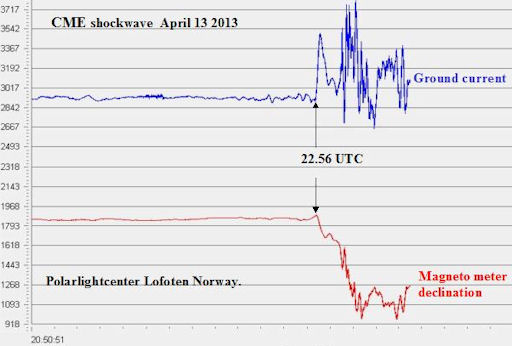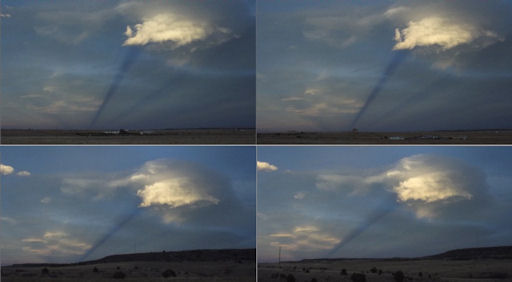When is the best time to see auroras? Where is the best place to go? And how do you photograph them? These questions and more are answered in a new book, Northern Lights - a Guide, by Pal Brekke & Fredrik Broms. | | |
SUNDAY EVENING PLANETS: When the sun sets on Sunday, April 14th, step outside and look west into the deepening twilight. The crescent Moon and Jupiter are in conjunction only a few degrees apart. It's a nice way to end the day. [sky map]
CME IMPACT: A coronal mass ejection (CME) swept past Earth on April 13th around 22:55 UT. The impact rattled Earth's magnetic field and induced electrical currents in the ground around the Arctic Circle. Rob Stammes recorded the effects of the impact from a geophysical monitoring station at the Polar Light Center in Lofoten, Norway:

"On my instruments there was a clear sugnature of the incoming coronal mass ejection," says Stammes. "The impact was not as strong as expected, but there were nice variations on my magnetometer and ground current instruments. There were also Northern Lights."
So far geomagnetic activity resulting from the impact has fallen short of storm levels, but this could change as Earth passes through the wake of the CME. High-latitude sky watchers should remain alert for auroras. on April 13-14. Aurora alerts: text, voice.
Realtime Aurora Photo Gallery
3D ANTI-CREPUSCULAR RAYS: Yesterday, near sunset, Larry Perkins was driving along highway I-25 north of Walsenberg, Colorado, when he saw a pair of dark rays lance across the sky. Using the motion of the car to change his perspective, he was able to photograph several stereo pairs. Cross your eyes to see the phenomenon in 3D:

The technical term for the phenomenon is "anticrepuscular rays"--that is, cloud shadows that point away from the setting sun.
"Slowly cross your eyes until the shadows merge," advises Perkins. "I find the shape of the lenticular cloud creating the rays as interesting as the rays themselves. The cloud is cylindrical and shrouded in a thin foggy shell."
Note: If you have trouble seeing the 3D effect in the small images, above, try these larger pairs instead.
Realtime Space Weather Photo Gallery
Realtime Aurora Photo Gallery
Realtime Comet Photo Gallery
Realtime Noctilucent Cloud Photo Gallery
[previous years: 2003, 2004, 2005, 2006, 2007, 2008, 2009, 2011]

